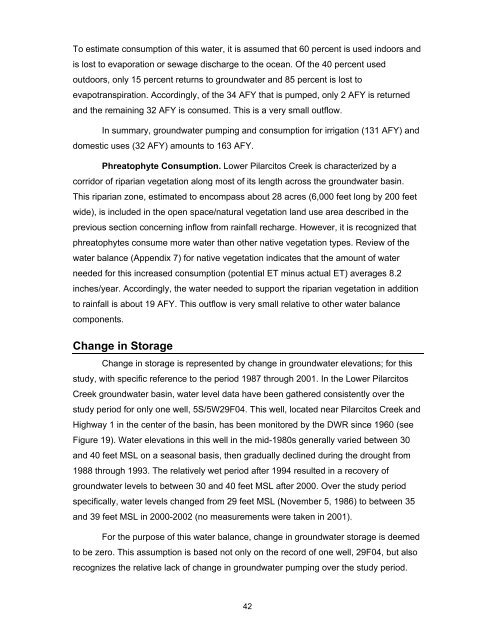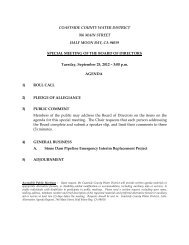Lower Pilarcitos Creek Groundwater Basin Study - Coastside ...
Lower Pilarcitos Creek Groundwater Basin Study - Coastside ...
Lower Pilarcitos Creek Groundwater Basin Study - Coastside ...
You also want an ePaper? Increase the reach of your titles
YUMPU automatically turns print PDFs into web optimized ePapers that Google loves.
To estimate consumption of this water, it is assumed that 60 percent is used indoors and<br />
is lost to evaporation or sewage discharge to the ocean. Of the 40 percent used<br />
outdoors, only 15 percent returns to groundwater and 85 percent is lost to<br />
evapotranspiration. Accordingly, of the 34 AFY that is pumped, only 2 AFY is returned<br />
and the remaining 32 AFY is consumed. This is a very small outflow.<br />
In summary, groundwater pumping and consumption for irrigation (131 AFY) and<br />
domestic uses (32 AFY) amounts to 163 AFY.<br />
Phreatophyte Consumption. <strong>Lower</strong> <strong>Pilarcitos</strong> <strong>Creek</strong> is characterized by a<br />
corridor of riparian vegetation along most of its length across the groundwater basin.<br />
This riparian zone, estimated to encompass about 28 acres (6,000 feet long by 200 feet<br />
wide), is included in the open space/natural vegetation land use area described in the<br />
previous section concerning inflow from rainfall recharge. However, it is recognized that<br />
phreatophytes consume more water than other native vegetation types. Review of the<br />
water balance (Appendix 7) for native vegetation indicates that the amount of water<br />
needed for this increased consumption (potential ET minus actual ET) averages 8.2<br />
inches/year. Accordingly, the water needed to support the riparian vegetation in addition<br />
to rainfall is about 19 AFY. This outflow is very small relative to other water balance<br />
components.<br />
Change in Storage<br />
Change in storage is represented by change in groundwater elevations; for this<br />
study, with specific reference to the period 1987 through 2001. In the <strong>Lower</strong> <strong>Pilarcitos</strong><br />
<strong>Creek</strong> groundwater basin, water level data have been gathered consistently over the<br />
study period for only one well, 5S/5W29F04. This well, located near <strong>Pilarcitos</strong> <strong>Creek</strong> and<br />
Highway 1 in the center of the basin, has been monitored by the DWR since 1960 (see<br />
Figure 19). Water elevations in this well in the mid-1980s generally varied between 30<br />
and 40 feet MSL on a seasonal basis, then gradually declined during the drought from<br />
1988 through 1993. The relatively wet period after 1994 resulted in a recovery of<br />
groundwater levels to between 30 and 40 feet MSL after 2000. Over the study period<br />
specifically, water levels changed from 29 feet MSL (November 5, 1986) to between 35<br />
and 39 feet MSL in 2000-2002 (no measurements were taken in 2001).<br />
For the purpose of this water balance, change in groundwater storage is deemed<br />
to be zero. This assumption is based not only on the record of one well, 29F04, but also<br />
recognizes the relative lack of change in groundwater pumping over the study period.<br />
42



